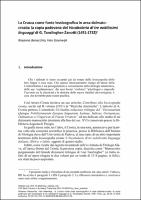Chapter La Crusca come fonte lessicografica in area dalmato-croata: la copia padovana del Vocabolario di tre nobilissimi linguaggi di G. Tanzlingher-Zanotti (1651-1732)
| dc.contributor.author | Steenwijk, Han | |
| dc.contributor.author | Benacchio, Rosanna | |
| dc.date.accessioned | 2022-09-15T20:06:35Z | |
| dc.date.available | 2022-09-15T20:06:35Z | |
| dc.date.issued | 2019 | |
| dc.identifier | ONIX_20220915_9788864539102_55 | |
| dc.identifier.issn | 2612-7679 | |
| dc.identifier.uri | https://library.oapen.org/handle/20.500.12657/58259 | |
| dc.language | Italian | |
| dc.relation.ispartofseries | Biblioteca di Studi Slavistici | |
| dc.subject.classification | thema EDItEUR::J Society and Social Sciences::JH Sociology and anthropology::JHB Sociology | en_US |
| dc.subject.other | Croatia | |
| dc.subject.other | Italy | |
| dc.subject.other | Latin | |
| dc.subject.other | lexicography | |
| dc.subject.other | 17th century | |
| dc.title | Chapter La Crusca come fonte lessicografica in area dalmato-croata: la copia padovana del Vocabolario di tre nobilissimi linguaggi di G. Tanzlingher-Zanotti (1651-1732) | |
| dc.type | chapter | |
| oapen.abstract.otherlanguage | The Vocabolario di tre nobilissimi linguaggi, produced by Ivan Tanzlingher-Zanotti between the latter half of the 17th and the beginning of the 18th century, currently exists in four manuscript versions: one is located in Zagreb, another in London, a third in Padova, and the fourth discovered only recently in Zadar. We focus on the Padova manuscript, which represents Tanzlingher’s mature work, to show that it differs importantly from other lexicographical works originating in 17th-century Dalmatia: while those are based on Latin models, here Tanzlingher turns for the first time to the Crusca Dictionary (Vocabolario degli Accademici della Crusca). | |
| oapen.identifier.doi | 10.36253/978-88-6453-910-2.05 | |
| oapen.relation.isPublishedBy | bf65d21a-78e5-4ba2-983a-dbfa90962870 | |
| oapen.relation.isbn | 9788864539102 | |
| oapen.series.number | 43 | |
| oapen.pages | 10 | |
| oapen.place.publication | Florence |

